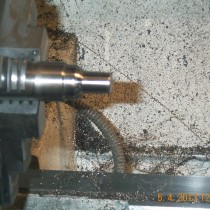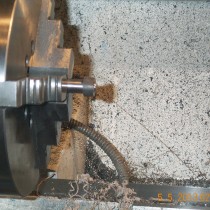You are here
Sliding tap holder for tail-stock
Tapping with the tail-stock while under power (spindle is turned on, tap locked into drill chuck) is quick and easy with certain size taps but, too big can be tough, too small and they brake.
Over the years ive seen a design floating around internet forums and blogs that makes tapping with smaller taps easier and less prone of braking them. I liked the concept and decided to make one myself.
The idea is to hold (with your hand) a sleeve that is "free floating" in your tail-stock, kick the spindle on and push the tap into the part while holding the sleeve with your hand... this way you can feel the tap cutting and if you let go of the sleeve, both the tap and sleeve will just spin and not brake the tap.
The the tap in held a drill chuck (or like wise), the drill chuck is mounted to a sleeve, the sleeve slides on a bar, the bar is held/fixed in the tail-stock. The sleeve can slide up and down (or in and out, how ever you would like to word it) on the bar and can also spin, the travel of this is up to how you make the gadget.
Anyway... here my take on a sliding tap holder.
The travel of this one is 2.5"
As for as metal goes... i dont have a lot (most of what i do have was taken from chip/scrap hoppers at work (before "they" put an end to that and no more metal could leave the building)) and if i can "make do" with what i have and not have to buy any, that’s what i do... so this project is a bit of a "piece meal" and if i had different raw material on hand would have done it alittle different.
Started with:
- 1/32 - 1/2 drill chuck from Grizzle (it was a cheap-o ($4.50 each (bought 5 of them)) with a taper B16).
- A scrape piece of bar stock that was 1.125 OD, 4" long and was drilled out to .562 - this will be the sleeve.
- A scrap slug, around .75" OD and 1.75 long (used this as a plug, welded it to the end of the 1.25 bar and then turned a B16 taper on the end)
- Another scrap slug, around 1.5 OD and an inch or so long, this will be a cap to hold in a Delrin bushing on the other end of the sleeve
- Two pieces of Delrin, one used as a bushing fitted in the end of sleeve and the other as a guide screwed on the end of the 1/2 rod.
- Piece of 1/2 bar stock, used as the main "rod" which the sleeve will ride on.
Here the sleeve...
One end has a 1" - 20 OD thread .375 long with a .687 bore .5 deep. A bushing will be placed in the bore and then a cap screwed on the end to hold it in place.
The other end is where the plug was welded in and then a B16 taper turned for the drill chuck. Opened up the .562 hole a bit and then ran a 5/8 reamer down it which the Delrin "guide" screwed to the end of the 1/2 rod will slide in.
The round over was done by hand with the carriage wheels then cleaned up with a file, this was to hide the poor welding job.
Heres the rod with the Delrin guide. Turned the guide OD over size, drilled and then taped it 3/8-16 and cut it off, then screwed it to the end of the 1/2 rod and over tightened it over the shoulder alittle, then turned the OD to size, faced & back faced it square.
During a test assembly i found that there was "suction" (back presser ???) while sliding the sleeve up and down the rod so i drilled two "air holes", one right in the end of the M16 tapper and the second through the side of the sleeve towards the back near the cap. The two air holes made a big difference, the "plunger" now slid nice and smooth.
For the welding, i only have a small MIG welder and Flex-Core wire (do not have any gas), the sleeve and plug are both made from stainless steel and thats a No-No (from what im told) with flux-core wire so i a added roll pin just to reinforce the M16 taper end.
The end result... I tested it out with a 10-24 tap into a blind hole and it worked well. I slide the "slider" all the way out to the end of its travel, brought the tail-stock forward till the tip of the tap was flush with the end of the part and locked it down... then i wheeled the tail-stocks quill in the distance i wanted to tap and locked it, kicked on the spindle, slide the tap forward and whent to work - every thing panned out. The thought of milling some flats for a wrench or drilling a though hole in the side of the sleeve to use a pipe for "torque/leverage" crossed my mind, but this is for smaller taps... Maybe down the line if ever needed. One thing which i may do is try and drill and tap a hole in the side of the drill chuck for a screw to lock on the flat of the taps to keep them from spinning in the chuck... always hate that.
| Save Article as PDF Error | Current URL Address Error |









Comments
Making the inner shaft with
Making the inner shaft with the "guide" screwed on the end was clever, with-out that you could not set it up to do blind holes like you did. Gonna have to add this to my todo list - thanks
Add new comment